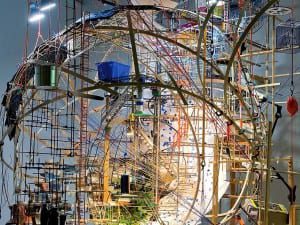The painter Sonia Delaunay (1885-1979) was one of the most creative and groundbreaking female artists of the 20th century and this retrospective at Tate Modern highlights her innovative designs. This international exhibition provides a tour of Delaunay’s career and includes her famous fashion and textile designs. Her revolutionary new designs also became used on clothing, swimsuits and theatre costumes.
Born into a Russian Jewish family in 1885, Delaunay’s first marriage to a German art critic helped to establish her on the artistic and literary scene of the time. Her journey to become one of the most influential artists of the 20th century was aided by the modernism that was sweeping through the art industry from 1911 to 1920 – with Pablo Picasso, Georges Braque and Salvador Dalí beginning to use radical new artistic methods. If you think of famous paintings such as Picasso’s Guernica, you can understand how the use of colour, shape and perspective were changing as styles like Impressionism were pushed aside by Cubism and Futurism.
The artist’s early work on display in the exhibition shows the influence of the Cubist and Futurist style of art that was emerging in the early 1920s. Cubism was a style that was widely derided at the time but gave artists more scope to create designs that broke up objects and patterns in the painting. A collage effect was then created and this form is mirrored in much of the early work on display in this exhibition. The effect of looking at the artist’s paintings and designs is very similar to the effect of looking through a kaleidoscope, with the boundaries of colour and perspective changing in each design. The rooms dedicated to the artist’s later work show that she was also using ceramics and includes futuristic designs. Many iconic female artists such as Georgia O’Keefe are prolific and like to experiment, and this exhibition is a classic example of an artist maturing and changing over time.
The breakthrough moment came in 1911 when a homemade patchwork quilt for her son’s crib showed an innovative use of geometry and colour which became the hallmark of her work. This new style echoed the new movement known in Paris as simultaneisme, which involved experimentation with blending colour. The artist used this homemade experiment to create her own version of simultaneisme, which became popular and widely recognised in its own right. It is possible to see how her use of colour was echoed in later works by artists such as Mark Rotho, who became aware of how subtle use of colour can have a dramatic effect on the viewer.
During the World War I, her first ventures into theatre took place culminating in commercial fashion design in Madrid. Fashion and art, as well as book illustration provided her with the breeding ground she needed to hone her art. She also designed mural decorations for the Air Transport Pavilion at the International Exhibition of Art and Technology in Modern Life. The final rooms of the presentation show her experimenting with a more profoundly abstract design and also introduce the viewer to her many etchings and drawings. Like another visionary, Leonardo da Vinci, this artist was simply streets ahead of her time.
The EY Exhibition: Sonia Delaunay, until 9 August, Tate Modern, Southbank, London.
Bryony Lanham
Credits
1. Sonia Delaunay Rhythm Colour no. 1076, 1939 Centre National des Arts Plastiques/Fonds National d’Art Contemporain, Paris, on loan to Palais des Beaux-Arts de Lille © Pracusa 2014083.





